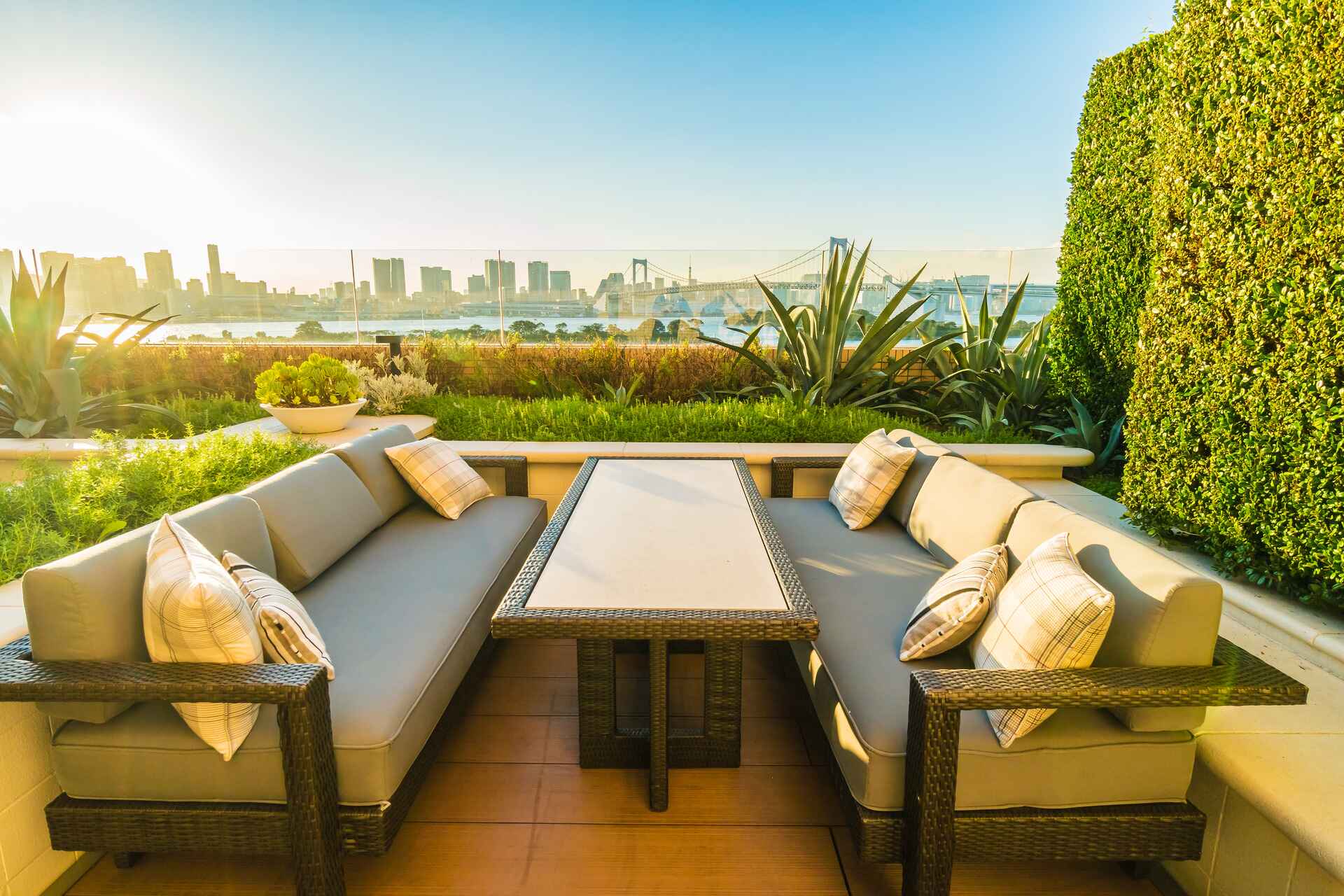Creating a Rooftop Garden - What to Know Beforehand
If you're interested in creating a rooftop garden on your roof, you've come to the right place. Read this article to learn what this project entails.
.webp)
Before investing in this project, you need to be aware of the requirements for installing a rooftop garden. Aside from having the correct building and planning permits, you also need to make sure your building can take the weight of a rooftop garden. It also helps to be informed about what plants to use, how to maintain the garden, and how much this entire project will cost.
Are you wondering how to go about creating a rooftop garden?
Rooftop gardens are a great way to transform unused space into a place to relax and enjoy the greenery. Along with many other benefits, rooftop gardens provide a peaceful retreat in the city.
But before starting this exciting project, there are several important factors to think about.
Your building needs to be strong enough to support the extra weight of the substrate, plants, and water. You'll also need to think about drainage, waterproofing, and professional maintenance.
You should also check local regulations and building codes to make sure you are allowed to install a rooftop garden.
With proper planning, you can enjoy the beauty and benefits of a rooftop garden for years to come.
Different Types of Rooftop Gardens
Before you start the process of creating a rooftop garden, you should know which type of green roof is the best fit for your building.
There are two main types of green roofs: extensive and intensive green roofs.
Extensive green roofs have a thin layer of substrate, usually shallower than 250mm.
They are intended for aesthetic and environmental purposes. Since they are more lightweight, they need less maintenance.
Intensive green roofs are typically deeper than 250mm, which is why they allow for a greater diversity of plants.
These types of green roofs provide spaces for everyday use where residents can spend time and unwind. But, since they're heavier and deeper, they require more maintenance.

The type of green roof you should choose depends on the structural capacity of your building. The choice also depends on your goals and budget.
An extensive green roof is ideal if you want a low-maintenance, lightweight option.
It's better suited for buildings with limited load-bearing capacity and for those seeking a simple, eco-friendly solution.
An intensive green roof allows for a more diverse plant selection, but it requires a stronger roof structure and higher maintenance.
If you want an accessible, visually rich green space and can handle the added weight and cost, an intensive roof is the better choice.
Permits and Local Regulations
Before you even start planning this project, you need to make sure you are legally allowed to do so. You need permission to install a green roof.
Here is a list of things to check before starting this project:
- Local building codes
- Zoning regulations
- Permits
- Stormwater management and environmental regulations
- Fire safety codes
Australia has strict National Construction Code (NCC) regulations that dictate structural requirements. This includes the load-bearing capacity of buildings.
You will need to comply with these standards, especially since green roofs add significant weight.
Different local councils across Australia have their own zoning laws, which might affect the installation of green roofs.
For example, some councils may restrict changes to the external appearance of buildings, particularly in heritage areas.
You typically need a development application (DA) for major building modifications, including green roofs.
But this can vary depending on your local council. The scale of your green roof project also matters.
Many Australian cities, especially Melbourne, Sydney, and Brisbane, are implementing strict stormwater management regulations.
Green roofs are increasingly seen as a way to mitigate stormwater runoff. Local councils may require you to comply with specific guidelines. Doing so ensures the roof performs this function effectively.
You also have to check fire safety regulations.
Green roofs must comply with Australian Standard AS 3959. This regulation applies to construction in bushfire-prone areas.
You can consult a qualified engineer for questions regarding these permits.
The Structural Integrity of the Building
Now that you have made sure you are legally permitted to install a rooftop garden, you have to make sure your building can handle it.
Plants, substrate, and water can be heavy. The added weight may be more than your roof is designed to support.
This is especially important if you want to install an intensive green roof.
If the roof is too weak, it could crack or collapse. To avoid this, it's important to have a structural engineer check your building.
They will calculate how much weight your roof can safely carry. This process is called a load-bearing assessment.
If the roof isn't strong enough, you might need to reinforce it before installing the garden. The structural engineer might suggest using a combination of methods based on your building's specific design.
Water is another factor to think about. Rain can make the garden heavier because the substrate absorbs water.
You'll also need to think about drainage to avoid water pooling on your roof, which adds more weight and can cause leaks.
By understanding the limits of your roof, you can choose the right type of green roof and avoid any safety risks.
Water Management
When installing a green roof, water management is critical to make sure the roof functions properly.
Without proper water management, excess water can lead to leaks, roof damage, or plant health issues.
Water management includes three important factors:
- Drainage
- Irrigation systems
- Stormwater management
A green roof requires a drainage layer to allow excess water to flow away.
This layer is typically made of lightweight materials like perforated plastic or gravel. It ensures that water doesn't pool on the roof. Pooling can lead to leaks, structural stress, or plant root rot.
A green roof must balance retaining water for plant use and draining excess.
Some green roof systems use water retention mats or layers that hold moisture while allowing excess water to escape. This helps keep the plants hydrated without overwhelming the roof with water.
Beneath the substrate and plants, a high-quality waterproofing membrane must be installed.
This layer is essential to prevent water from seeping into the roof structure and causing damage.
In drier climates or during periods of low rainfall, irrigation systems may be needed.
This could include drip irrigation or automated watering systems. An irrigation system makes sure plants get enough water without overwhelming the drainage system.
Green roofs can play a role in stormwater management. They can slow down and filter rainwater before it reaches the ground.
Proper drainage helps manage how much water is absorbed by the plants and substrate. It also controls how much water is directed to gutters or rainwater harvesting systems.
Plant Selection
When you take all these factors into consideration, you will know what type of green roof you want.
Based on this decision, you are now free to choose the best plants for your rooftop garden.
Extensive green roofs have a shallow layer of substrate and require lower maintenance needs. That's why they go with lightweight, drought-resistant plants that need little water and care.
These are some plants you can plant on your extensive green roof:
- Sedums
- Grass
- Moss
- Herbs
- Wildflowers
- Succulents
Intensive green roofs are deeper, which is why they can support a wider variety of plants. These types of green roofs can also handle trees and small shrubs.
If you want an intensive green roof, here are some plants you can add:
- Shrubs
- Perennials
- Vegetables
- Grass and sedges
- Vines and climbers
- Small trees
It's also important to choose plants based on the climate. Do you live in a drought-prone area, or does it rain a lot where you live?
These are key factors to take into account.
It's best to consult with a green roof specialist, like Evergreen Infrastructure, when choosing plants for your green roof.

Maintenance Requirements
When installing a rooftop garden, it's not only important to be prepared for the project. You also have to know what comes after.
No matter what type of green roof you choose, you will have to maintain it periodically.
Extensive green roofs require minimal maintenance. They are typically planted with drought-tolerant, low-maintenance plants like sedums and grasses.
Maintenance involves:
- Periodic weeding
- Checking drainage systems
- Ensuring the plants are healthy
Intensive green roofs need more frequent maintenance, similar to a traditional garden. This includes:
- Regular watering
- Fertilizing
- Pruning
- Pest control
- Seasonal plant care.
Some plants may require manual watering or an automatic irrigation system, especially in dry climates or during hot months.
It's important to consider how often and how much watering the plants will need.
It's also vital to inspect the garden regularly to make sure everything is functioning properly.
This includes checking the waterproofing membrane for leaks, making sure the plants are healthy, and looking for any signs of structural issues on the roof.
Understanding these maintenance requirements helps you plan your budget, time, and effort. It also helps ensure the garden remains sustainable and healthy year-round.
Cost and Budgeting
If you're planning to install a rooftop garden, you also have to be financially prepared. There are two types of costs to consider - initial and ongoing costs.
Initial installation costs can include:
- Structural assessment
- Roof reinforcement
- Waterproofing and drainage
- Planting materials
- Irrigation system installation
Ongoing costs typically comprise regular maintenance and necessary repairs and replacements.
Keep in mind that the type of green roof you will choose will also impact the price. Intensive green roofs are more expensive than extensive green roofs.
Depending on your local area, you may need to obtain building permits or development approvals for a rooftop garden. This is especially true if you are making structural changes.
These permits come with associated fees, which vary by location.

By considering these costs in your budget, you can make sure your rooftop garden project is financially sustainable from installation through long-term maintenance.
Proper planning will help you avoid overspending and make the most of your investment.
How to Build a Rooftop Garden
Creating a rooftop garden is a rewarding way to transform unused space into a beautiful and eco-friendly area.
However, careful planning is essential.
You must make sure your building can handle the extra weight, account for proper drainage, and be prepared for ongoing maintenance.
It's also important to consider the costs of installation, permits, and upkeep.
With the right approach and attention to detail, a rooftop garden can provide long-term benefits, both for you and the environment, while offering a peaceful green space above the city.
Evergreen Infrastructure would be happy to help you create the perfect rooftop garden.
As qualified green roof specialists, we know exactly what the process will look like from start to finish. After a thorough inspection, we can tell you what type of roof is the best solution for your building.
We will also make sure it's properly installed. The final product will be a beautiful rooftop garden that will pay off in more ways than one.
Call us if you want to know more.
{{cta}}
We create green oases in urban settings
We'd love to discuss how we can partner to bring innovative, sustainable solutions to your urban environment.
.webp)
.webp)
.webp)

.png)
